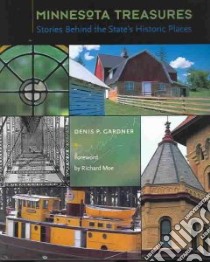- Libreria
- >
- Libri in lingua
- >
- Storia e archeologia
- >
- Storia
Minnesota Treasures - 9780873514712
Un libro in lingua di Denis Gardner Moe Richard (FRW) edito da Minnesota Historical Society Pr, 2004
- € 41.30
- Il prezzo è variabile in funzione del cambio della valuta d’origine
Why should we save the historic buildings in our cities and towns? What makes a building a historic landmark? What can we uncover of Minnesota's history by studying its historic structures? What do buildings and sites tell us about time and place, experience and memory, people and their needs? Historian Denis P. Gardner beckons us to learn about the profound value of historic buildings and places in this engaging collection of essays. His stories, accompanied by gorgeous color photographs, tell the very human side of our state?s history by showcasing some of the state's gathering places, houses, commercial hubs, industrial and agricultural properties, and Native American sites that hold our collective history. Read about Guri Endreson, a Norwegian immigrant widow who defiantly returned to the family?s small log cabin near Willmar after her husband and son were killed in the U.S.-Dakota War--and see the evocative photograph of the log structure as it stands today. Or hear of the second-most famous aviator in Minnesota history, Bernard H. Pietenpol, who built airplanes in his garage/workshop in the heart of Cherry Grove, and see one of his prototype airplanes preserved for display. Learn of the wood-framed Classical Hennepin County house of one of Minnesota's most prominent African Americans, Lena Olive Smith, and hear how Smith, the first African American women licensed to practice law in Minnesota, was a tireless crusader for equal rights. As Richard Moe, president of the National Trust for Historic Preservation, writes in the foreword to Minnesota Treasures: These places help us understand who we are . . . they constitute a unique family portrait of us. And what a colorful, complex, endlessly fascinating portrait it is. In their remarkable variety, the places in Minnesota Treasures may at first glance appear to be a random collection of unrelated artifacts--but in fact they share one very important trait in common: They are all worth saving. Just as we learn about our fathers and mothers--who they were, what they believed, how they lived--from the buildings they left for us, our children will learn about us in the same way.
Informazioni bibliografiche
- Titolo del Libro in lingua: Minnesota Treasures
- Sottotitolo: Stories Behind the State's Historic Places
- Lingua: English
- Autori : Denis Gardner Moe Richard (FRW)
- Editore: Minnesota Historical Society Pr
- Collana: Minnesota Historical Society Pr (Hardcover)
- Data di Pubblicazione: 01 Aprile '04
- Genere: Lingua Inglese
- Argomenti : Historic sites Minnesota
- Dimensioni mm: 266 x 228 x 44
- ISBN-10: 0873514718
- EAN-13: 9780873514712


